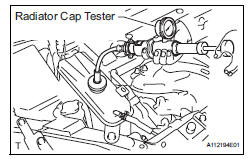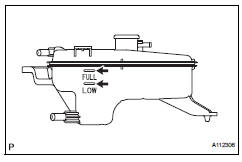Toyota RAV4 (XA40) 2013-2018 Service Manual: Cooling system
On-vehicle inspection
- Check cooling system for lea
ks
- Remove the radiator reservoir cap.
Caution:
To avoid the danger of being burned, do not remove the radiator reservoir cap while the engine and radiator are still hot. Thermal expansion will cause hot engine coolant and steam to blow out from the radiator reservoir.

- Fill the radiator and reservoir with coolant, and then attach a radiator cap tester.
- Warm up the engine.
- Pump the radiator cap tester to 118 kpa (1.2 Kgf/
cm2, 17.1 Psi), and then check that the pressure
does not drop.
If the pressure drops, check the hoses, radiator and water pump for leakage.
If there are no signs of external coolant leaks, check the heater core, cylinder block and head.
- Reinstall the radiator reservoir cap.
- Check engine coolant level of reservoir

- The engine coolant should be between the low
and full lines when the engine is cold.
If low, check for leakage and add toyota super long life coolant (sllc) or similar high quality ethylene glycol based non-silicate, non-amine, nonnitrite, and non-borate coolant with long-life hybrid organic acid technology up to the full line
- Check engine coolant quality
- Remove the radiator reservoir cap.
Caution:
To avoid the danger of being burned, do not remove the radiator reservoir cap while the engine and radiator are still hot. Thermal expansion will cause hot engine coolant and steam to blow out from the radiator.
- Check for any excessive deposits of rust or scale
around the radiator reservoir cap and radiator filler
hole; the coolant should be free of oil.
If excessively dirty, replace the coolant.
- Install the radiator reservoir cap.
 Battery current sensor
Battery current sensor
On-vehicle inspection
Check battery current sensor assembly
Measure the resistance of the sensor.
Standard resistance
If the result is not as specified, replace the sensor
assembly.
...
 Cooling fan system
Cooling fan system
Parts location
System diagram
On-vehicle inspection
Hint:
It is normal for the cooling fan to sometimes rotate when the
ignition switch is turned from acc to on.
Check cooling fan ope ...
Other materials:
Srs airbag instructions
for canadian owners
(in french)
The following is a french explanation of srs airbag instructions
extracted from the srs airbag section in this manual.
See the srs airbag section for more detailed srs airbag instructions
in english.
Coussins gonflables srs avant
Coussin gonflable srs du conducteur/coussin gonflable srs ...
Checking tires
Check if the treadwear indicators
are showing on the tires.
Also check the tires for uneven
wear, such as excessive wear
on one side of the tread.
Check the spare tire condition
and pressure if not rotated.
New tread
Worn tread
Treadwear indicator
The location of treadwear indicators
is show ...
Checking the battery
Check the battery as follows.
â– Battery exterior
Make sure that the battery terminals
are not corroded and that
there are no loose connections,
cracks, or loose clamps.
Terminals
Hold-down clamp
â– Before recharging
When recharging, the battery produces
hydrogen gas which is flammable
and exp ...
